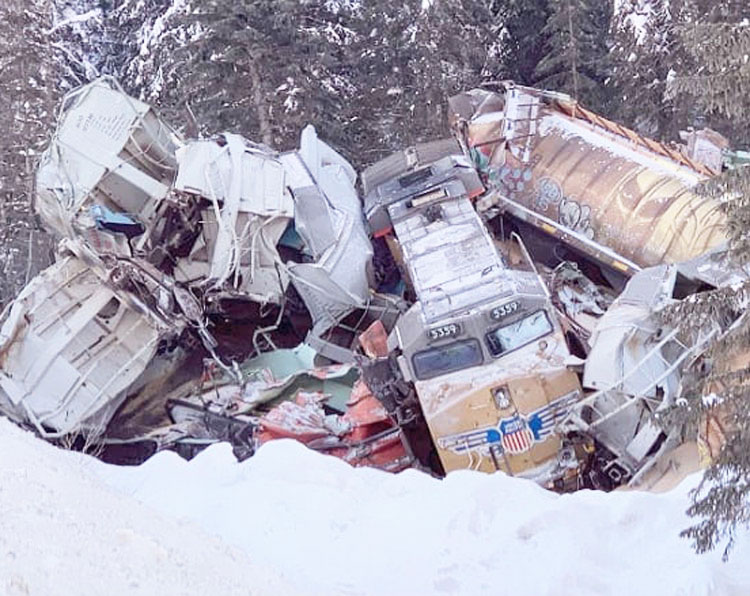On April 28 the Teamsters Canada Rail Conference commemorated Workers Memorial Day by honoring eight rail workers who had been killed on the job in Canada since November 2017. The day is an annual remembrance by labor organizations in North America and beyond of workers who have been killed or injured at work.
Three rail workers — Canadian Pacific engineer Andrew Dockrell, conductor Dylan Paradis and trainee Daniel Waldenberger-Bulmer — were killed Feb. 4 when their train rolled down one of the steepest grades in North America without adequate air brakes, in the Rocky Mountains in British Columbia near the Alberta boundary. The train had three engines pulling 112 loaded grain hoppers, weighing over 11,000 tons. It was over 5,500 feet long.
This slope has been the site of numerous runaway trains and derailments over the last century, including one just a month before this deadly crash.
The crew had just relieved an earlier crew when the train, which had been parked on the grade with its air brakes on for almost three hours, started to roll. The workers were unable to get the train under control and it derailed on a curve ahead of a bridge over the Kicking Horse River. The crew in the lead locomotive was killed when the engine hit the ground and went into the river in sub-zero temperatures. Only 13 cars and the tail-end locomotive remained on the tracks. Investigators from the Canadian Transportation Safety Board indicated April 19 that it was shoddy inspection and maintenance by rail bosses that was responsible.
The safety board investigators reported the previous crew had parked the train after it began to speed up and applying the brakes didn’t control it. They put the locomotive into emergency, stopping it on the 2.2% grade and left the air brakes applied. But the brakes slowly lost their grip on the train.
The relief crew was only on the train for 10 minutes when it started to roll. The Transportation Safety Board took the 13 grain cars left on the tracks and tested their brakes in conditions similar to those the night of the disaster. “The air brake system on these cars would not provide adequate braking effectiveness to ensure the safe operation of a loaded unit grain train,” safety board officials reported.
They urged government regulators to review the rules covering air brake maintenance and inspections, especially for railroads like Canadian Pacific that operate over mountainous terrain. “A properly functioning air brake system is of the utmost importance in mountain territory,” the safety board wrote.
After the derailment, the Canadian transportation minister ordered handbrakes be applied on trains stopped on steep mountain slopes, a measure supported by the rail union. But Canadian Pacific and the Canadian National Railway are appealing the ruling, which would slow down train operations and cut into their profits.
Bosses attack safety conditions
With longer and heavier trains, smaller crews, cuts in train and track maintenance, schedules that dictate constant fatigue, and refusal by bosses to implement union-supported safety measures, rail workers are put in increasingly dangerous conditions as bosses seek to maximize their profits. With layoffs and speedup over the last couple of years, 3,000 engineers and conductors now do the work previously done by 4,300 workers at Canadian Pacific. The bosses are pushing to cut crews down to one, and some even to none, run by remote control operation from miles away. The Teamsters says the training for new engineers has been cut in half to just three months.
Canadian Pacific bosses, for their part, crowed that April was a record-setting month, hauling 2.64 million metric tons of grain and grain products. And, they had the nerve to brag, it was the best April in their history, with train length averaging 7,576 feet and train weight 9,356 tons.
These longer, heavier trains are a deadly danger to both rail workers and those who live in communities along the tracks.
At least 24 rail workers died on the job across North America in 2018. Carman Allen Lowe, 46, a union rail worker for 25 years, was killed at the CSX Wauhatchie Rail Yard in Chattanooga, Tennessee, April 13 when he was struck by a locomotive. His death is being investigated.
“We need to educate, organize, and mobilize the union, to explain that there is no solution for a safe workplace except what I was taught on the job by fellow rail workers in 1960 — to use union power and fight for workers control,” Joe Swanson, who worked on the railroad for 31 years and is the Socialist Workers Party candidate for mayor of Lincoln, Nebraska, told the Militant.
“We should fight for no trains over 50 cars in length, with four-person crews, including two engineers in the locomotive and two workers on a caboose or engine in the rear. The increase in crew size and increase in trains will provide much needed jobs for thousands in hard-hit working-class communities across North America,” he said.


